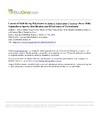Please use this identifier to cite or link to this item:
https://accedacris.ulpgc.es/jspui/handle/10553/46543
| DC Field | Value | Language |
|---|---|---|
| dc.contributor.author | Bilbao Villena, Amaia | en_US |
| dc.contributor.author | Núñez, Jorge | en_US |
| dc.contributor.author | Viera, Mara Del Pino | en_US |
| dc.contributor.author | Sosa, Beatriz | en_US |
| dc.contributor.author | Fernández-Palacios, Hipólito | en_US |
| dc.contributor.author | Hernández-Cruz, Carmen María | en_US |
| dc.date.accessioned | 2018-11-23T05:36:59Z | - |
| dc.date.available | 2018-11-23T05:36:59Z | - |
| dc.date.issued | 2011 | en_US |
| dc.identifier.issn | 0730-8000 | en_US |
| dc.identifier.uri | https://accedacris.ulpgc.es/handle/10553/46543 | - |
| dc.description.abstract | The experimental culture of Haliotis tuberculata coccinea is carried out at the Institute of Marine Science of Canary Islands (Gran Canaria, Spain) based on specimens captured in their natural habitat and conditioned as broodstock. In 2008, an outbreak of shell-boring polychaetes affected the culture. This study aims to identify some of the species of shell-boring polychaetes that affect H. tuberculata coccinea and, second, to assess the effectiveness of multiple mebendazole applications for the control of these pests. Mebendazole was applied as baths of Lomper (Esteve Laboratory, Barcelona, Spain) using the concentrations 6 mL/L, 8 mL/L, and 10 mL/L, with 0 mL/L as a control measure. Abalone were exposed to 3 mebendazole baths over a 3-day period (1× 3-h bath applied for 3 consecutive days), as recommended in the drug directions for human use. After each bath, the abalone were returned to their original culture tanks until the following day. After these 3 days, the abalone were kept in their original culture tanks for a term of 1 mo. Each month, as a result of the effect of mebendazole, moribund and/or dead polychaetes became detached from the burrows and were found at the bottom of the tank during the first 15 days after the baths of mebendazole were applied. The polychaetes expelled from the shells were counted, collected, and fixed in 10% buffered formaldehyde for subsequent identification. This process was repeated month after month until no moribund and/or dead shell-boring polychaetes were found after the application of the baths of mebendazole. The shell-boring polychaete species was identified as Polydora hoplura (Claparède 1870). The efficacy rate of Lomper was around 99% in all the concentrations tested when it was applied during a 7-mo term (each month, 1 bath was applied for 3 consecutive days), and abalone mortality was limited to highly infested animals only. Monitoring of abalone weight gain suggested that the mebendazole treatments did not affect growth significantly during the study period. | en_US |
| dc.language | eng | en_US |
| dc.publisher | 0730-8000 | - |
| dc.relation.ispartof | Journal of Shellfish Research | en_US |
| dc.source | Journal of Shellfish Research [ISSN 0730-8000],v. 30(2), p. 331-336 | en_US |
| dc.subject | 251092 Acuicultura marina | en_US |
| dc.subject.other | Abalone | en_US |
| dc.subject.other | Haliotis tuberculata coccinea | en_US |
| dc.subject.other | Polydora sp. | en_US |
| dc.subject.other | Mebendazole | en_US |
| dc.title | Control of shell-boring polychaetes in Haliotis tuberculata coccinea (Reeve 1846) aquaculture: Species identification and effectiveness of Mebendazole | en_US |
| dc.type | info:eu-repo/semantics/Article | en_US |
| dc.type | Article | en_US |
| dc.identifier.doi | 10.2983/035.030.0219 | en_US |
| dc.identifier.scopus | 80052310477 | - |
| dc.identifier.isi | 000294312200019 | - |
| dc.contributor.authorscopusid | 56249557600 | - |
| dc.contributor.authorscopusid | 7201854598 | - |
| dc.contributor.authorscopusid | 55391476200 | - |
| dc.contributor.authorscopusid | 8543861500 | - |
| dc.contributor.authorscopusid | 37054623100 | - |
| dc.contributor.authorscopusid | 6603285180 | - |
| dc.contributor.authorscopusid | 55935009000 | - |
| dc.description.lastpage | 336 | en_US |
| dc.description.firstpage | 331 | en_US |
| dc.relation.volume | 30 | en_US |
| dc.investigacion | Ciencias | en_US |
| dc.type2 | Artículo | en_US |
| dc.contributor.daisngid | 29058371 | - |
| dc.contributor.daisngid | 964553 | - |
| dc.contributor.daisngid | 5545240 | - |
| dc.contributor.daisngid | 7237664 | - |
| dc.contributor.daisngid | 1055780 | - |
| dc.contributor.daisngid | 1081294 | - |
| dc.utils.revision | Sí | en_US |
| dc.contributor.wosstandard | WOS:Bilbao, A | - |
| dc.contributor.wosstandard | WOS:Nunez, J | - |
| dc.contributor.wosstandard | WOS:Viera, MD | - |
| dc.contributor.wosstandard | WOS:Sosa, B | - |
| dc.contributor.wosstandard | WOS:Fernandez-Palacios, H | - |
| dc.contributor.wosstandard | WOS:Hernandez-Cruz, CM | - |
| dc.date.coverdate | Agosto 2011 | en_US |
| dc.identifier.ulpgc | Sí | en_US |
| dc.description.sjr | 0,548 | |
| dc.description.jcr | 0,793 | |
| dc.description.sjrq | Q3 | |
| dc.description.jcrq | Q4 | |
| dc.description.scie | SCIE | |
| item.fulltext | Con texto completo | - |
| item.grantfulltext | open | - |
| crisitem.author.dept | GIR ECOAQUA: Ecofisiología de Organismos Marinos | - |
| crisitem.author.dept | IU de Investigación en Acuicultura Sostenible y Ec | - |
| crisitem.author.dept | Departamento de Biología | - |
| crisitem.author.orcid | 0000-0003-1410-8154 | - |
| crisitem.author.orcid | 0000-0001-8048-3150 | - |
| crisitem.author.parentorg | IU de Investigación en Acuicultura Sostenible y Ec | - |
| crisitem.author.fullName | Bilbao Villena, Amaia | - |
| crisitem.author.fullName | Fernández Palacios, Hipólito | - |
| crisitem.author.fullName | Hernández Cruz, Carmen María | - |
| Appears in Collections: | Artículos | |
SCOPUSTM
Citations
9
checked on Jun 8, 2025
WEB OF SCIENCETM
Citations
8
checked on Jun 8, 2025
Page view(s)
97
checked on Jul 6, 2024
Download(s)
226
checked on Jul 6, 2024
Google ScholarTM
Check
Altmetric
Share
Export metadata
Items in accedaCRIS are protected by copyright, with all rights reserved, unless otherwise indicated.
